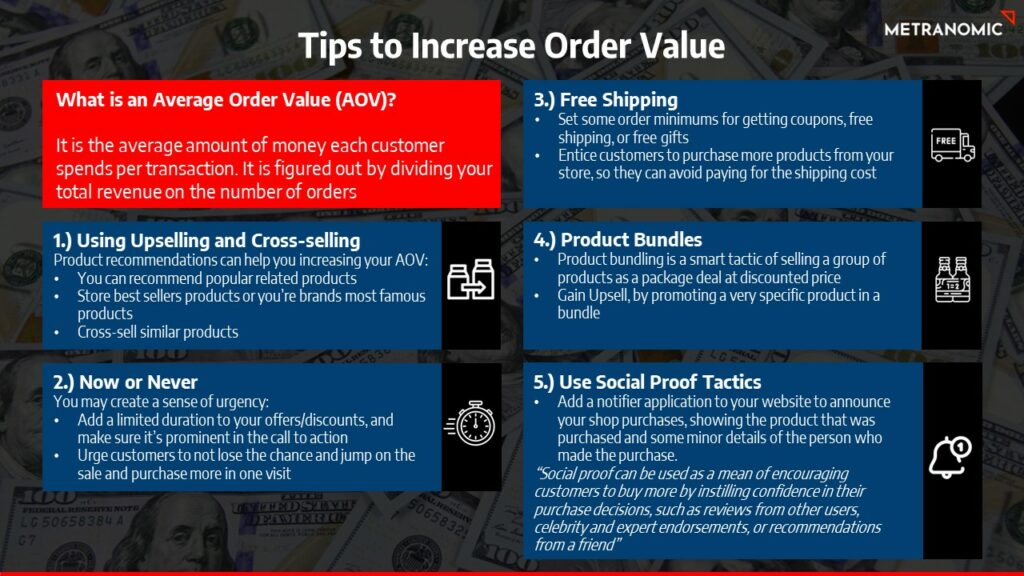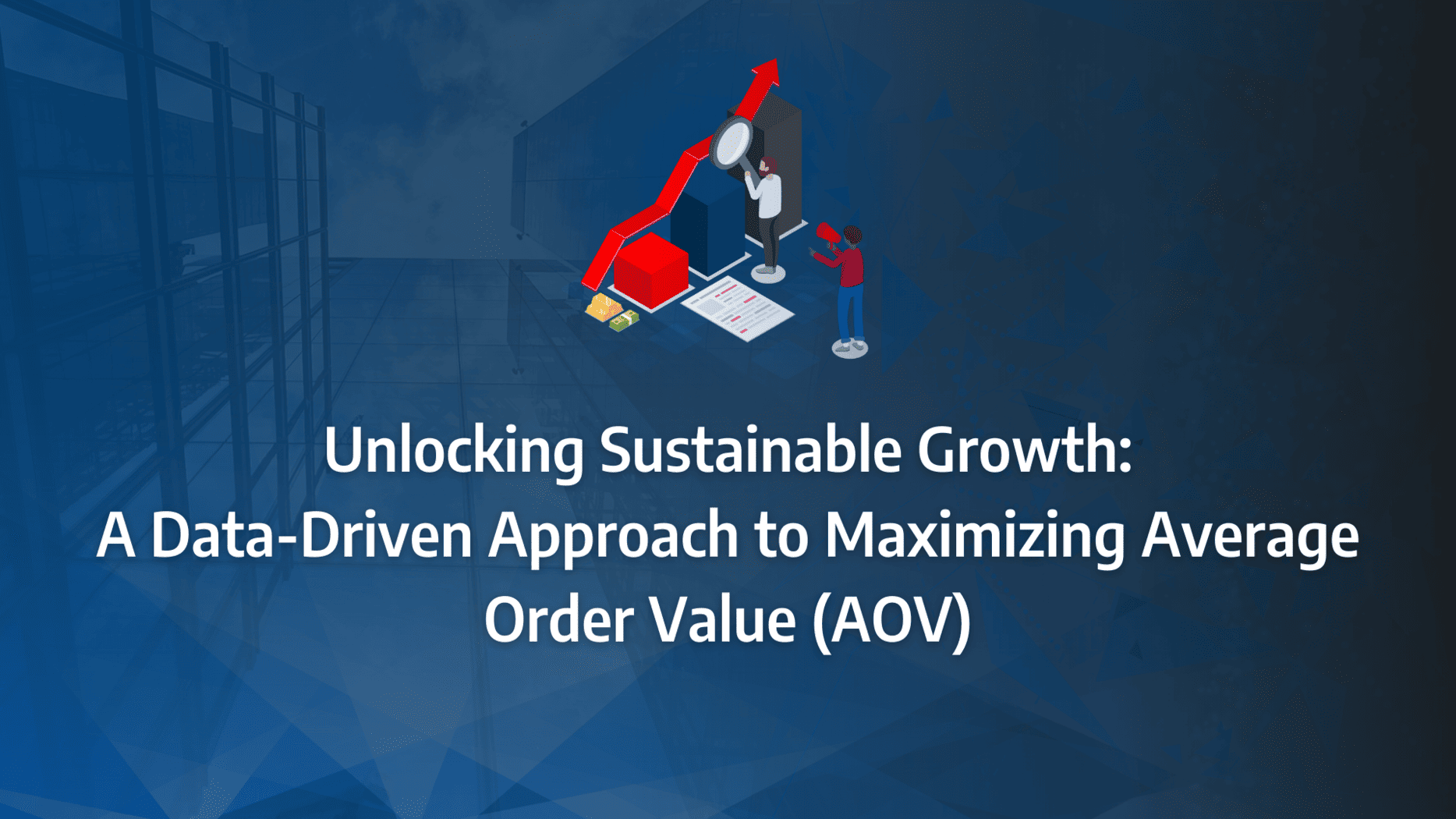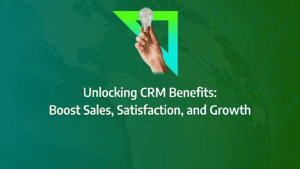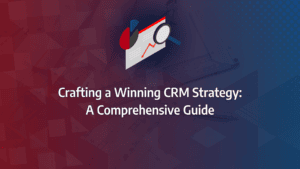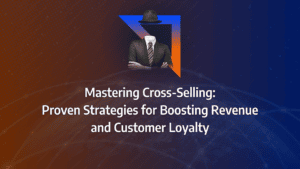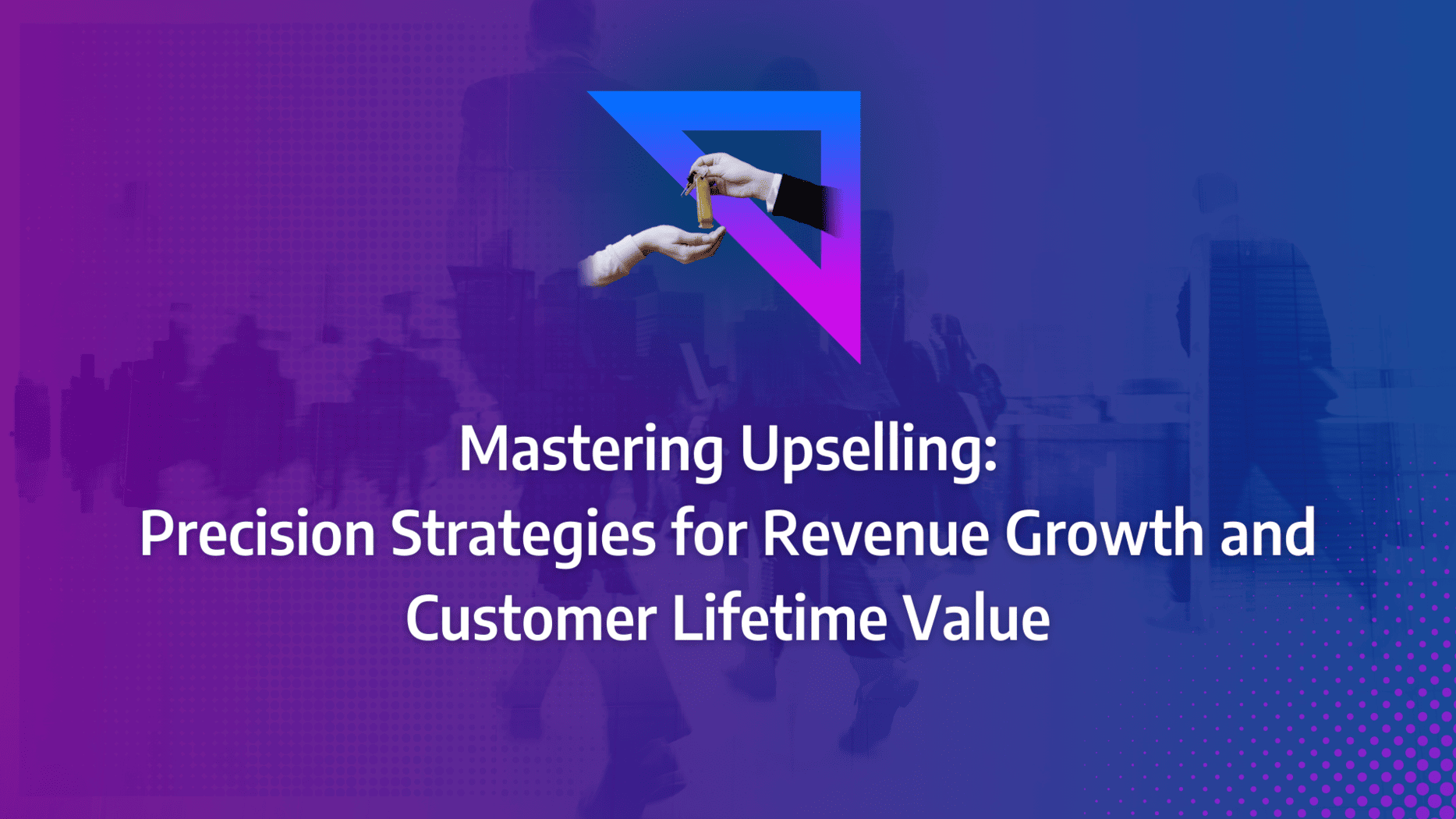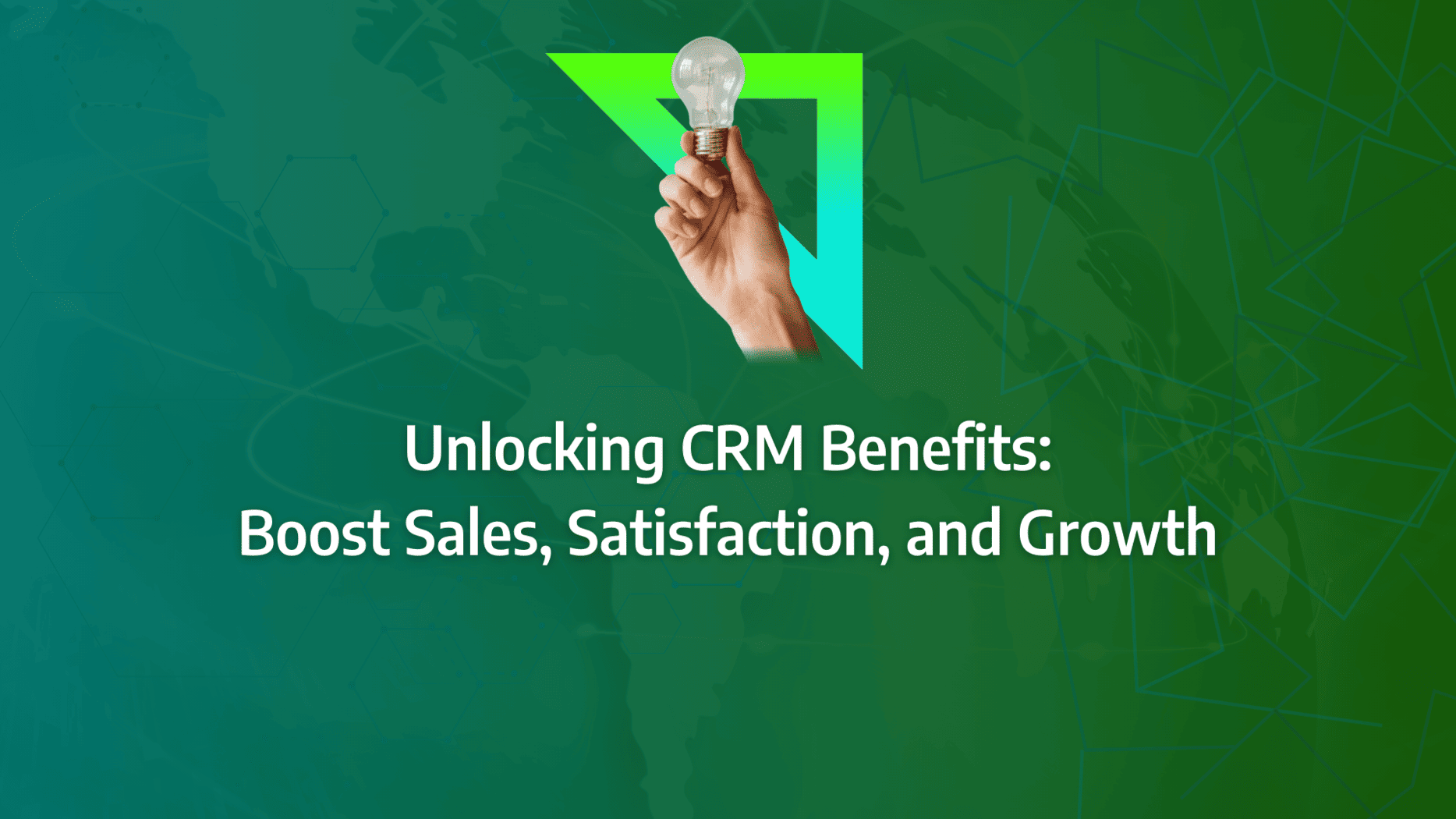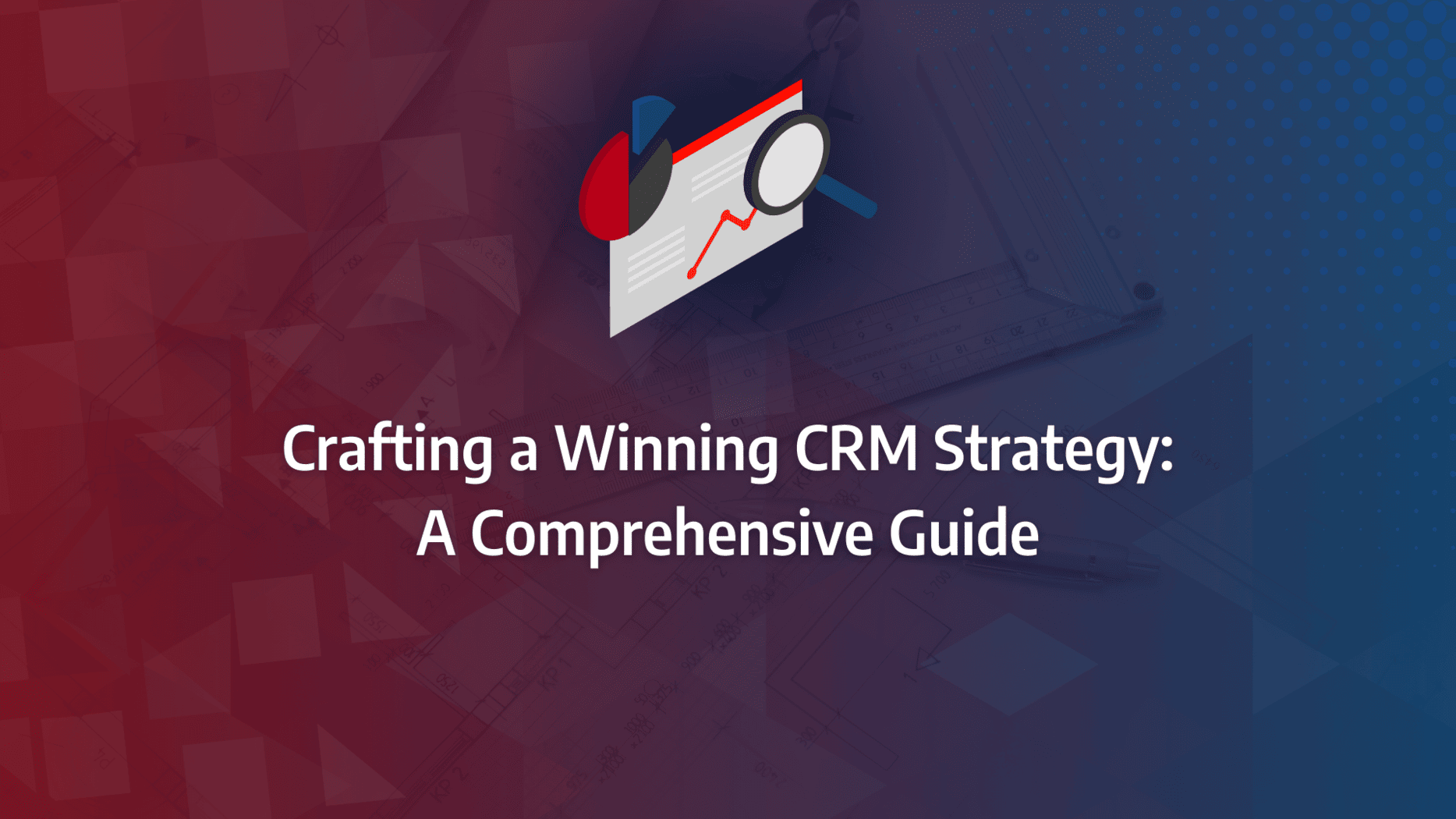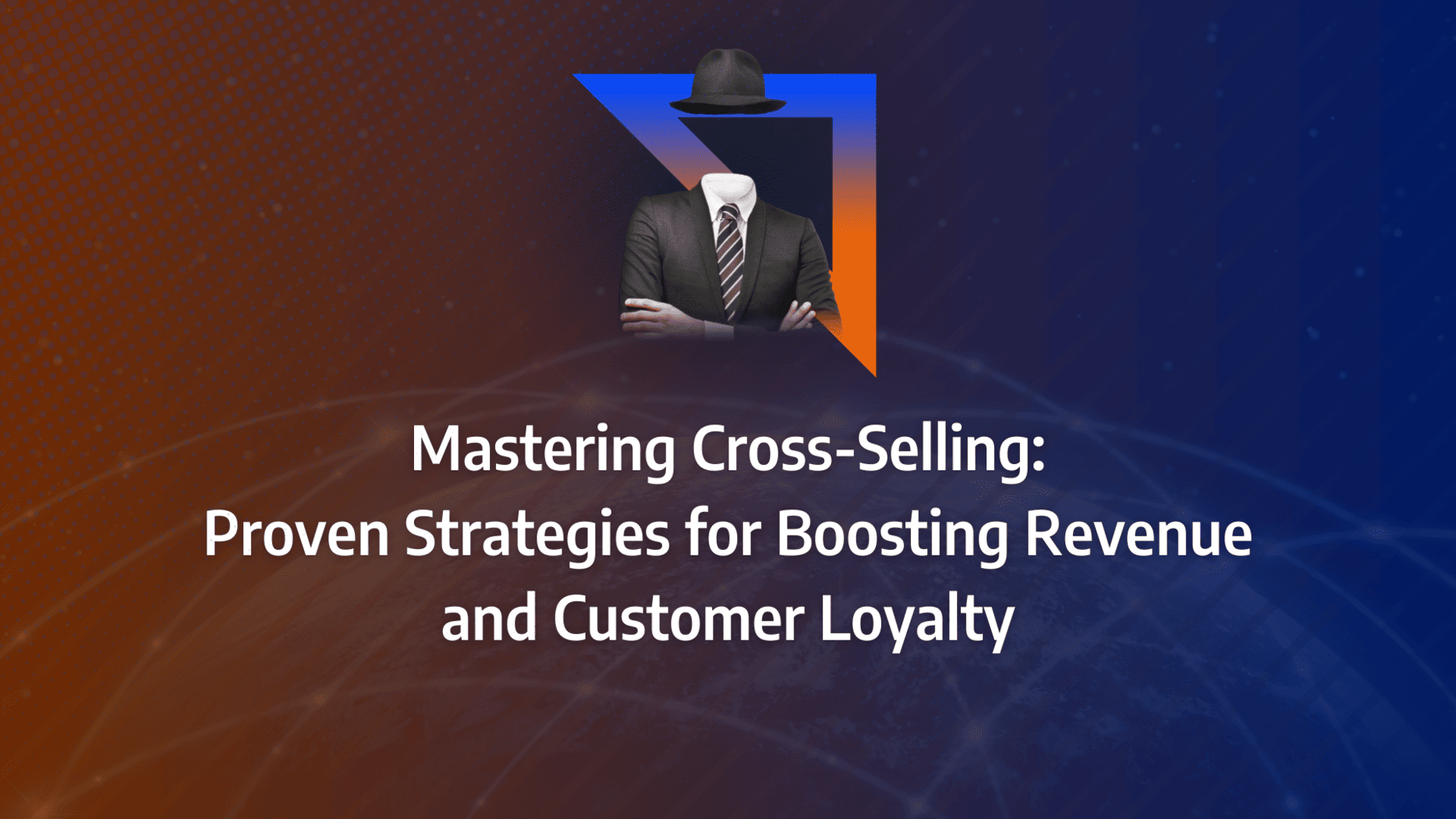Maintaining profitability while scaling your operations can be a daunting challenge. You’ve successfully attracted customers, but how can you ensure that each interaction maximises revenue without the constant pressure of acquiring new ones? This is where optimising your Average Order Value (AOV) becomes a game-changer.
Imagine increasing your revenue by encouraging customers to spend just a little more on each purchase. By implementing targeted strategies like upselling, cross-selling, and personalised offers, you can significantly boost your AOV, driving sustainable growth and enhancing customer satisfaction. This blog will guide you through actionable steps to optimise your AOV, helping you unlock the full potential of your business.
- Optimising AOV is critical for achieving sustainable growth without the need for constant customer acquisition, enabling businesses to improve profit margins effectively.
- Leverage upselling, cross-selling, and bundling strategies to increase AOV, offering customers more value while enhancing revenue per transaction.
- Utilise data-driven insights to personalise marketing efforts and tailor offers that resonate with different customer segments, leading to higher AOV.
- Incorporate AOV strategies into your digital marketing campaigns, focusing on personalised messaging, targeted promotions, and dynamic pricing to maximise effectiveness.
- Measure the impact of AOV strategies through key performance indicators like revenue per visitor, conversion rates, and customer lifetime value, ensuring continuous optimisation.
- Be mindful of potential challenges such as over-promotion and customer fatigue, balancing profitability with customer satisfaction to maintain a positive brand experience.
What is the Average Order Value?
Average Order Value (AOV) is a pivotal eCommerce metric that calculates the mean total of each order placed with a merchant over a specified period. This measure, known as the AOV formula, is integral to understanding customer spending habits. Average order value is crucial for online retailers as it influences key business decisions such as advertising expenditure, store layout, and product pricing strategies.
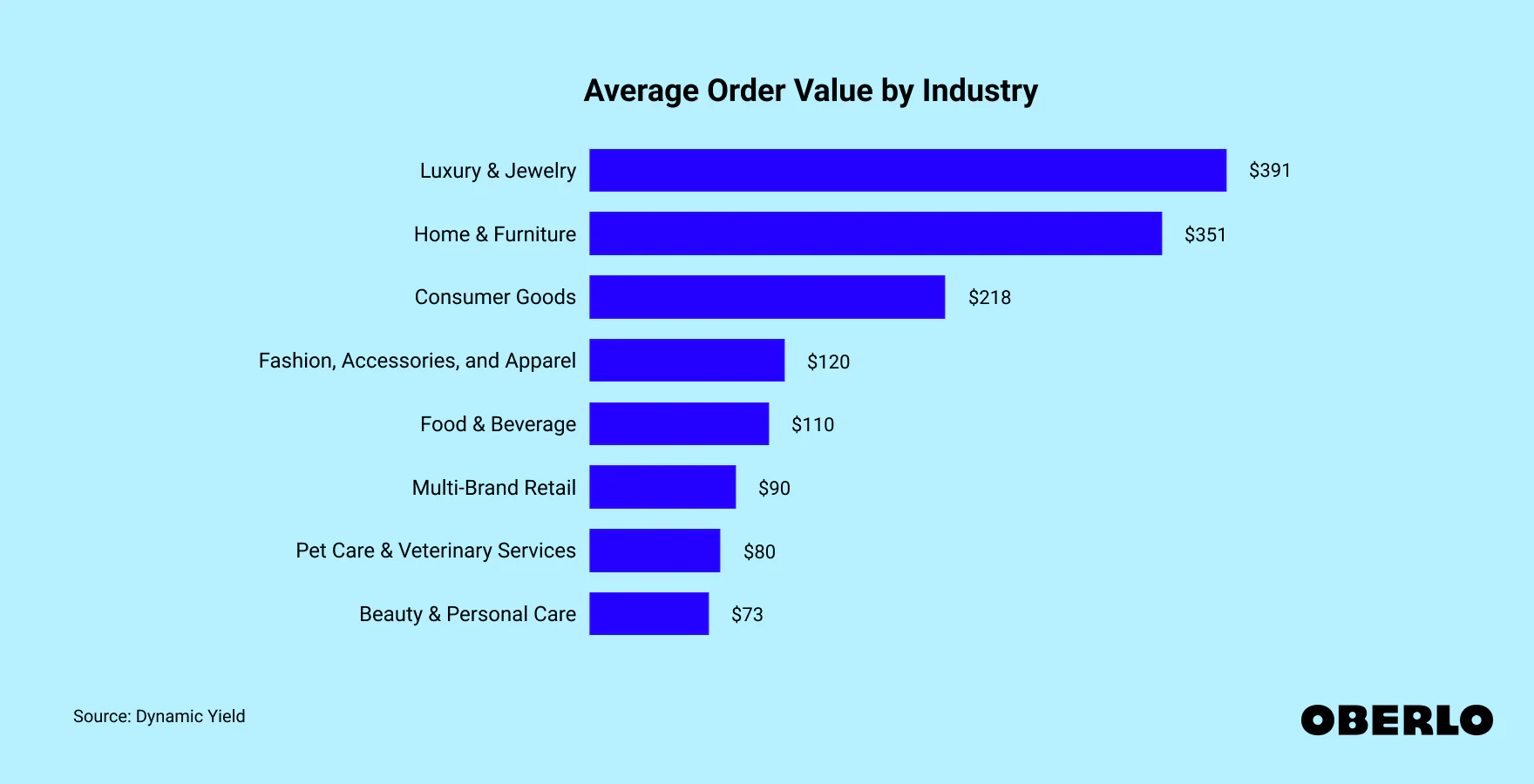
What Matters Most?
From our experience, increasing Average Order Value goes beyond simple tactics; it requires a deep understanding of customer psychology. Clients often discover that leveraging emotional drivers, such as crafting personalised product recommendations based on emotional resonance, can significantly boost upsell success. Customer segmentation typically allows businesses to target high-value customers with exclusive offers, tapping into their willingness to spend more.Get In Touch
By focusing on increasing the average order value, businesses can enhance their overall revenue without necessarily increasing the number of customers. This metric allows merchants to evaluate the effectiveness of their marketing strategies and adjust their approaches to maximise profitability. For instance, an optimised aov formula can guide a business in determining the most effective minimum order thresholds for free shipping offers or the best ways to bundle products.
The average order value serves as a critical indicator of a business’s health. It provides insights into consumer behaviour, helping marketers to tailor their strategies to boost sales. Techniques such as upselling, cross-selling, and offering loyalty programmes are directly influenced by the average order value, making it an indispensable metric for eCommerce success.
Understanding and applying the aov formula effectively can lead to more informed decisions in various aspects of online retail, from inventory management to personalised marketing campaigns. By analysing aov in digital marketing, businesses can develop strategies that not only attract new customers but also enhance the value derived from each transaction.
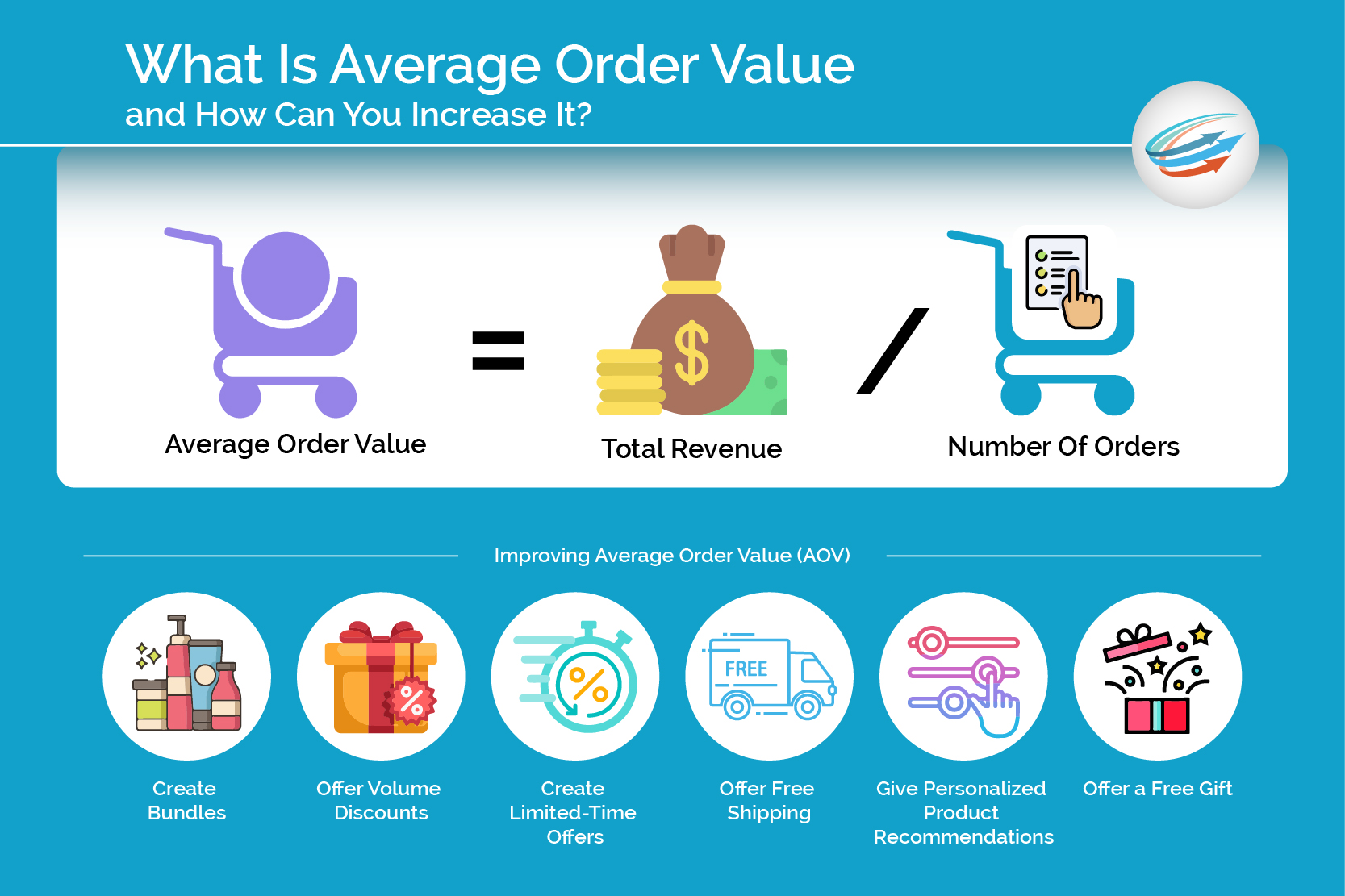
Top Strategies to Increase the Average Order Value
1. Create an Order Minimum for Free Shipping and Gifts
Free shipping remains an effective strategy to encourage customers to increase their spend. Setting this up with platforms like Shopify is straightforward.
To determine your threshold, start with your modal order value – the most common order value. For instance, if the majority of your orders are around £35, you might offer free shipping for orders over £50. Marketing expert Aaron Zakowski suggests setting this threshold at 30% higher than your AOV. This strategy ensures that free shipping feels attainable for most customers, thereby boosting your average order value. However, setting the threshold too high can lead to abandoned carts.
Consider the example of Kinda Hot Sauce: if they had set their free shipping threshold at £35 based on an AOV of £24, many customers with orders around £15 would likely abandon their carts. If your goal is to filter out lower-paying customers, this could be effective, but typically, that’s not the intention.
An alternative to free shipping is offering discounts for orders above a certain threshold. For example, you could offer a £10 coupon for orders over £50 or a 10% discount, though this latter option can make profits less predictable.
Kopari Beauty effectively uses this tactic by offering free gifts with a minimum purchase and promoting this through in-cart messaging.
2. Bundle Products or Create Packages
To encourage customers to buy more, consider creating product bundles that cost less than purchasing the items individually. Bundling increases the perceived value of a customer’s purchase.
For example, BioLite offers bundles that include a stove and accessories – essentials for cooking while camping. This approach simplifies the buying process for customers, ensuring they get everything they need in one purchase, while also increasing your average order value.
Allowing customers to create their own bundles can also be effective. For instance, Contrado lets customers design their own face masks and add premium materials, white labeling, and other unique features that can raise the order total.
3. Upsell or Cross-Sell Complementary Products
Upselling and cross-selling are classic techniques, epitomised by the famous “Would you like fries with that?” These strategies encourage customers to purchase complementary or upgraded versions of the products they are already interested in.
However, overuse can diminish returns. Preetam Nath from DelightChat suggests evolving your upselling strategy by offering recommendations in a way that feels helpful and genuine, akin to a friend’s suggestion. Instead of suggesting popular items, hand-pick products that perfectly complement the item in the user’s cart, like a mouse for a laptop or batteries for a remote control.
Offering low-value upsells can also increase the likelihood of purchase. It’s easier to convince someone to add a £20 product to their £50-£100 order than to get them to purchase another £100 item.
For a low-risk strategy, test post-purchase upsells. Brands concerned about conversion rates can use apps like ReConvert to implement this. Using data to understand which products are commonly bought together can help in creating pre-purchase bundles that appeal to customers.
Our Tactical Recommendations
In our work, small adjustments to the checkout flow can make a major impact on AOV. Clients often discover that post-purchase upsells are particularly effective because they do not disrupt the purchase process, offering a seamless way to increase spend. Testing product placements and call-to-action buttons is another tactic we have seen work well, typically revealing opportunities to optimise the customer journey for higher-value orders. Scarcity techniques, such as countdown timers or limited-time offers, usually create urgency, driving customers to make larger purchases to avoid missing out.Get In Touch
4. Set Up a Customer Loyalty Programme
If your store sells consumable products—items customers regularly repurchase, such as razors or shaving cream—consider establishing a rewards or loyalty programme. This retention strategy helps build stronger relationships with your customers, encouraging repeat purchases and enhancing their overall experience.
It’s essential to ensure your loyalty programme evolves with consumer preferences. During times of economic uncertainty or a global pandemic, for example, offering lavish rewards for high spending may not be appropriate. Claire’s, a retailer targeting teens and tweens, recently introduced a loyalty programme that offers cashback incentives (£5 back for every 100 points). This approach resonates with their young clientele, who appreciate the value of every pound spent.
By incentivising customers to earn points through your loyalty programme, you can expect to see a significant increase in your average order value. The aov formula indicates that a well-structured loyalty programme can effectively boost both customer retention and spending.
5. Provide Fully Staffed Live Chat Support for Quick Questions
Live chat often brings to mind images of support agents wearing headsets and resolving customer issues. However, live chat has evolved into a powerful tool for boosting sales, with businesses that implement it seeing a 10-15% increase in average order value per cart, according to Forrester.
Jaime Schmidt, founder of Schmidt’s Naturals and author of “Supermaker: Crafting Business on Your Own Terms,” refers to live chat as an “underutilised weapon” for increasing AOV. By offering immediate answers to customer queries, live chat reduces the likelihood of abandoned carts and increases the potential for sales.
Live chat is particularly beneficial for high-ticket items like mattresses and furniture, where customers may need more guidance before making a purchase. Online shopping requires customers to commit to products they often cannot see in person, so providing real-time support can significantly enhance their confidence to buy.
In addition to live chat, product reviews, testimonials, and other forms of social proof can also play a crucial role. However, live chat has the unique advantage of addressing immediate concerns and questions, making it a vital component in the strategy to increase your average order value.
Implementing these strategies can lead to a substantial improvement in your average order value. By understanding the aov formula and the role of aov in digital marketing, you can develop a comprehensive approach that enhances both customer satisfaction and revenue growth.
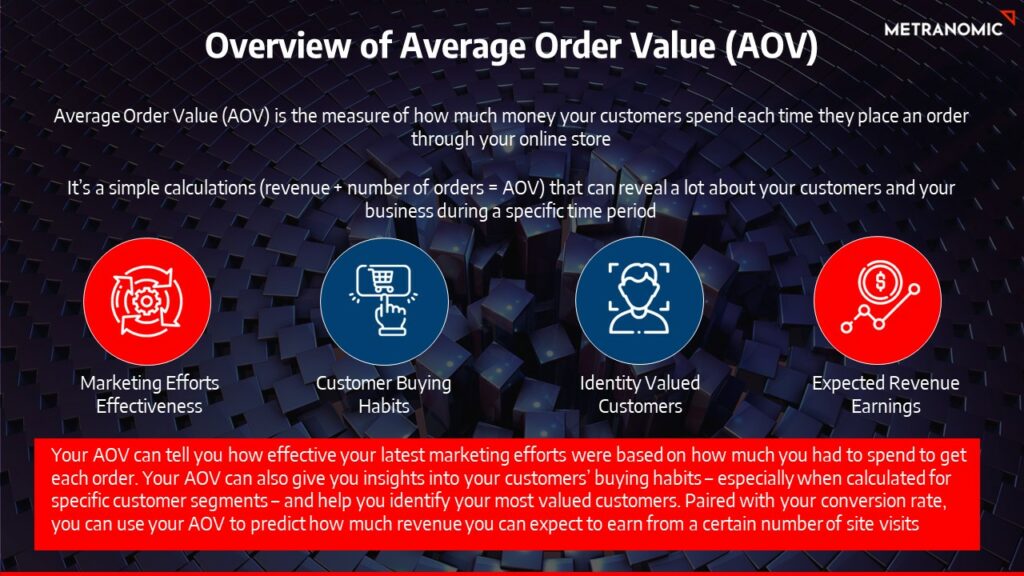
Tips to Support You in Launching and Implementing These Strategies
1. Create Order Minimums for Free Shipping
To encourage customers to add more products to their carts, you can offer free shipping if their order surpasses a certain amount. For instance, you could provide free shipping for orders over £50. This common strategy helps to increase the average order value significantly.
When offering free shipping with a minimum purchase amount, be sure to display this offer prominently across your website: on the homepage, product pages, and at checkout. This ensures customers are aware of the incentive to increase their order value.
2. Cross-Sell Complementary Products
Whenever possible, display or mention complementary products to your customers to encourage larger purchases. This can be as simple as indicating which items pair well together in your product descriptions. Make it clear through your messaging and store layout that your items offer greater value when combined with other products.
Many eCommerce platforms allow you to add complementary products to each customer’s cart, thus encouraging them to purchase additional items. This strategy leverages the aov formula to maximise the average order value by suggesting relevant add-ons.
3. Upsell Your Products
Similar to cross-selling, upselling involves suggesting more expensive versions of your products and positioning them as a “better value” to increase the average order value. For example, on a product page for older stock, recommend newer, similar (and pricier) products to your customers. This approach not only increases the average order value but also ensures that customers perceive the added value in opting for a premium product.
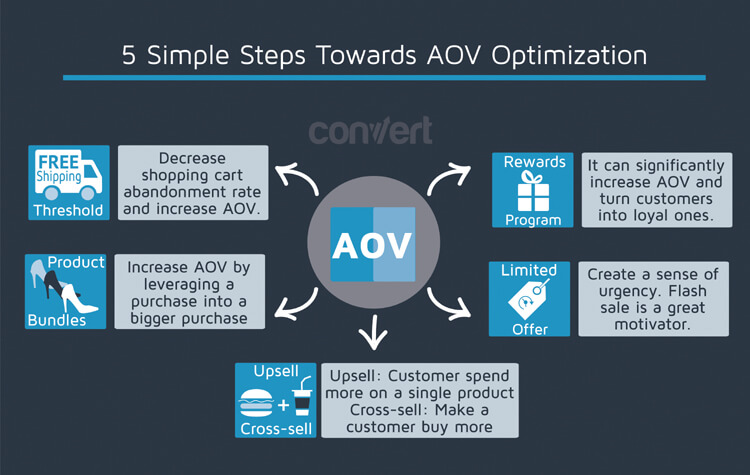
4. Provide Bundle Deals and Bulk Options
Grouping products that go well together or commonly sell together into “bundles” can encourage customers to buy a complete set rather than individual items. This strategy effectively increases the average order value by offering a package deal that appears more attractive than purchasing items separately.
Additionally, offering slight discounts for purchasing more than one of the same item can incentivise bulk buying. Customers are more likely to add extra items to their cart when they perceive a cost-saving opportunity.
5. Start a Customer Loyalty Programme
Loyalty programmes are a powerful tool to build your brand and increase average order value. A study by Smile.io found that loyalty programmes boost average order value by nearly 14% on average. These programmes not only encourage customers to add more to their orders but also enhance customer retention.
By creating a points-based system or offering exclusive discounts to loyal customers, you can significantly improve your average order value and customer loyalty.
6. Provide a More Personalised Experience
Use customer data to create more personalised and targeted shopping experiences that will increase your AOV. By analysing customers’ order histories, you can craft marketing campaigns with messaging and products that resonate with specific audiences. The more targeted and specific your marketing efforts, the more likely customers are to spend larger amounts.
7. Offer Limited-Time Promotions
Creating a sense of urgency can drive customers to increase their order value. Offering short-term discount codes (valid for 24-72 hours) on certain items can prompt customers to make quicker, larger purchases. This tactic leverages the psychological impact of missing out on a great deal to boost the average order value.
8. Gain Customers’ Trust with Social Proof
Displaying reviews and feedback from previous customers can significantly influence purchasing decisions. According to Search Engine Watch, 72% of consumers will only purchase a product after reading positive reviews. Prominently feature glowing reviews on your store’s webpages and marketing materials to entice and reassure customers, thus increasing your average order value.
9. Give a Free Gift or Gift Card with Purchase
Everyone loves a free gift. Offering a free gift or a coupon code with purchase can entice more customers to click “buy.” A store gift card or a coupon code not only encourages a purchase but also promotes repeat business, especially if the offer has an expiration date.
10. Establish a Flexible Return Policy
Transparency and flexibility in your return policy are crucial. A 2019 survey by UPS found that 73% of shoppers say their return experience influences their likelihood of buying from a retailer again. A flexible return policy can alleviate potential customers’ anxieties about making a purchase.
Clearly display your return policy in purchase confirmation emails, on social media accounts, and on website banners. This reassurance can encourage higher-value purchases, thereby increasing the average order value.
By implementing these strategies and understanding the aov formula, you can effectively enhance your aov in digital marketing, leading to increased profitability and customer satisfaction.
